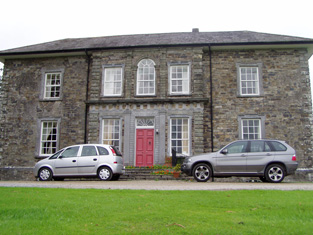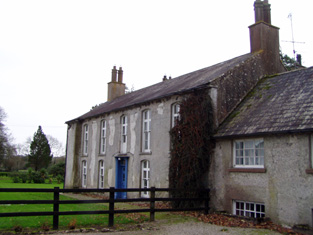Kilcor Castle
Houses within 5km of this house
Displaying 16 houses.
Houses within 5km of Kilcor Castle
Displaying 16 houses.
| House name | Description | |
|---|---|---|
| Aghern/Ahern House | Brabazon Esq was resident in the 1770s and 1780s. The home of Spotswood Bowles in the first half of the 19th century. The buildings were valued at £47+ in the early 1850s and held from the representatives of William Beamish. Spotswood died in 1864 and was succeeded by his son George who was in turn succeeded by his nephew Spotswood in 1886. Relatives of the Bowles owned this property until the 1970s. In 1942 the Irish Tourist Association Survey mentions the ruins of Aghern Castle in the grounds of Mrs. Spotswood Bowles property. Aghern was uninhabited for a time but has recently been restored. |

|
| Ballyvolane | Hajba writes that Ballyvolane was bought by Sir Richard Pyne of Waterpark, Lord Chief Justice of Ireland, from the Coppingers in the early 18th century. It remained in the possession of the Pyne family until the mid 20th century and is still occcupied. Valued at £44 at the time of Griffith's Valuation, the house was occupied by Jasper Pine who held it from Thomas, George and Henry Walker. By 1906 the mansion house at Ballyvolane was valued at £70+ and occupied by George M.Pyne. |

|
| Ballyrobert | Hajba writes that Michael Mackay built a house beside the ruined castle of Ballyrobert in the 1820s and he is recorded as resident there by Lewis in 1837. In the early 1850s the house was valued at £23, occupied by Michael Mackay and held from John Peard. Michael J. Mackey occupied the house in 1906. This house no longer exists. | |
| Coole Abbey | This house was the home of a branch of the Peard family until the early 20th century and is still inhabited. It was occupied by Richard Peard in 1814 and by Henry Hawk Peard in 1837. He was still resident in the early 1850s and held the house valued at £36 from James H. Smith Barry. By the end of the 19th century Orr McCausland was the owner of Coole Abbey. |

|
| Mohera | Hajba writes that Michael Mackay was recorded as resident here in 1824. By 1837 John O'Sullivan was resident and was still the occupier at the time of Griffith's Valuation. The buildings were then valued at £14 and the property was held from Major General Conyers. Home of the McAuliffes in the 20th century. |

|
| Rathbarry Cottage | Rathbarry Cottage was occupied by Major William Love Peard at the time of Griffith's Valuation. The property was held from the Reverend R. Gumbleton and the buildings were valued at £11. Some ruined walls remain at the site. | |
| Towermore | The home of Mrs Maria Oliver in 1837 but leased to Frederick C. Hayes in the early 1850s. The house was valued at £45. Maria was the widow of Charles S. Oliver of Inchera and a daughter of A. Morris of Dunkettle. A. Morris Oliver is recorded as a subscriber to Lewis ''Topographical Dictionary'' published in 1837 but is not mentioned in Burkes. Earlier, in 1786, Wilson refers to Tormore as the seat of Mr. Connor. This house was not occupied at the end of the 20th century although still extant. | |
| High Park | Occupied by the Reverend J. W. Edgar in 1837 and by Bridget Hogan in the mid 19th century, valued at £12+ and held from William Coppinger. This house no longer exists. | |
| Hollyhill | David Hallahan occupied Holy hill, Rathcormack, in 1814 and S. Croker in 1837. Eliza Croker held the property from Francis C. Reeves in the mid 19th century, when the buildings were valued at £11.10 shillings. [for this Croker family see http://members.iinet.net.au/~nickred/croker_research/The_Irish_CROKER.pdf page 121]. Later the home of the Campion and other families, this house is no longer extant. | |
| Mellefontstown | The main residence of the Nason family in the 18th century, John Nason was resident in 1814 and Pierce Cotter in the early 1850s. Cotter held the property from Thomas Wise and the buildings were valued at £19+. In May 1863 Pierce Joseph Cotter's estate at Mellifontstown, containing the house, demesne and 246 acres was advertised for sale. It was held on a lease dated 1852 from Francis Wise to Pierce Cotter for 185 years. A new house now stands on the site. | |
| Ballymacsimon | A house located on the Devonshire estate and occupied by John Kirby in the mid 19th century. The buildings were valued at £25. William Kirby held 2 townlands in the parish of Aghera at the time of Griffith's Valuation. Home of the Collins family in the mid 20th century and still inhabited. | |
| Killavarilly | At the time of Griffith's Valuation John O'Neill, a doctor, held a house valued at £25+ and 350 acres from the Duke of Devonshire at Killavarilly. A house is still located at this site. | |
| Ballinterry | Hajba writes that this property had passed from the Terrys to the Earls of Barrymore at the beginning of the 18th century. In 1814 it was the residence of the Reverend John Ross and in 1837 of Archdeacon Ryder. The Archdeacon was still resident at the time of Griffith's Valuation when the buildings were valued at £21. It now operates as a luxury guesthouse. |

|
| Castlelyons House | Situated on 2 acres in the centre of the town of Castlelyons this house was in the possession of the related clerical families of Browne and Ryder in the 18th and 19th centuries. Occupied by the Reverend Joshua B. Ryder in the mid 19th century. He held the property valued at £30 from Samuel Perrott. Still valued at £30 this house was occupied by the representatives of Andrew W. Ryder in 1906. |

|
| Berry Hill | The National Inventory of Architectural Heritage states that this house dating from circa 1700 was a dower house for the Barrymore family of Castlelyons Castle. By the mid 19th century it was in the possession of the Perrott family and occupied by the Reverend Philip Berry who held the buildings valued at £21 with 15 acres. This house is still occupied. |

|
| Castle Lyons | Wilson, writing in 176, refers to the accidental burning of the seat of the Earls of Barrymore. "The mansion house, with the furniture and a valuable collection of pictures, were entirely destroyed by an accidental fire". Some ruins remain at the site. A dower house, built by the Barry family towards the end of the 18th century, is still extant and known as Berryhill. . |

